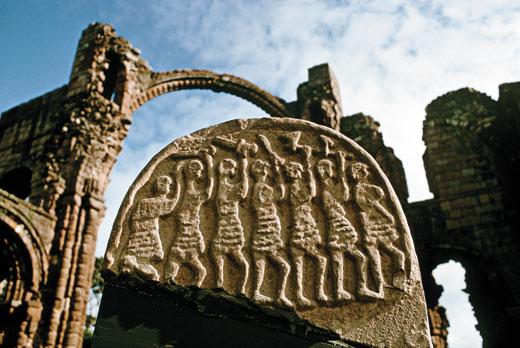A Viking mystery (3)
David Keys
Source : : http://www.smithsonianmag.com/history-archaeology/A-Viking-Mystery.html?c=y&page=1

After decades of peace, Vikings again raided England, in A.D. 980. At the time, the Anglo-Saxon ruler was King Aethelred the Unraed (literally “the ill-advised”). As his name suggests, popular history has portrayed him as a mediocre successor to Alfred the Great and Edgar the Peaceful. The 12th-century historian William of Malmesbury wrote that Aethelred “occupied rather than governed” the kingdom. “The career of his life was said to have been cruel in the beginning, wretched in the middle and disgraceful in the end.”
To avert war, Aethelred paid the Vikings some 26,000 pounds in silver between A.D. 991 and 994. In the years that followed, the king employed many of them as mercenaries to discourage other Vikings from attacking England.
But, in A.D. 997, some of the mercenaries turned on their royal employer and attacked the Anglo-Saxon southern counties. In early A.D. 1002, Aethelred again tried to buy off the Vikings—this time with 24,000 pounds in silver.
The geopolitical situation changed in England’s favor only when Aethelred made an alliance with Normandy and sealed the deal by marrying the Duke of Normandy’s sister in A.D. 1002. Possibly emboldened by the support of a powerful ally, Aethelred decided to take pre-emptive action before the Danes again broke the truce.
According to the Anglo-Saxon Chronicle, Aethelred was “informed” that Danish mercenaries intended to “beguile him out of his life.” (It is unknown whether an informer learned of an actual plot, or if Aethelred and his council fabricated the threat.) Aethelred then set in motion one of the most heinous acts of mass murder in English history, committed on St. Brice’s Day, November 13, 1002. As he himself recounted in a charter written two years later, “a decree was sent out by me, with the counsel of my leading men and magnates, to the effect that all the Danes who had sprung up in this island, sprouting like cockle [weeds] amongst the wheat, were to be destroyed by a most just extermination.”
Prior to 2008, the only known inhabitants of the St. John’s College garden had been the songbirds and squirrels that darted across the neatly cropped lawn and hid in an ancient beech tree. Generations of dons and students had strolled across that greenery, unsuspecting of what lay beneath.
The lab data indicating that the men buried there for 1,000 years had eaten lots of seafood, plus the burn markings and other evidence, convinced the archaeologists that the grave probably held victims of the St. Brice’s Day massacre. Aethelred himself recounted exactly how the residents of Oxford killed the Danes in a local church: “Striving to escape death, [the Danes] entered [a] sanctuary of Christ, having broken by force the doors and bolts, and resolved to make a refuge and defence for themselves therein against the people of the town and the suburbs; but when all the people in pursuit strove, forced by necessity, to drive them out, and could not, they set fire to the [building’s] timbers and burnt [it] down.”
Wallis, the archaeologist in charge at Oxford, surmises that the townspeople loaded the corpses onto a cart and drove out through the north gate of the city, past land that today encompasses the Oxford colleges of Balliol and most of St. John’s, then threw the Vikings into the prehistoric henge—the largest ditch nearest the city’s northern exit.
A SUIVRE ...